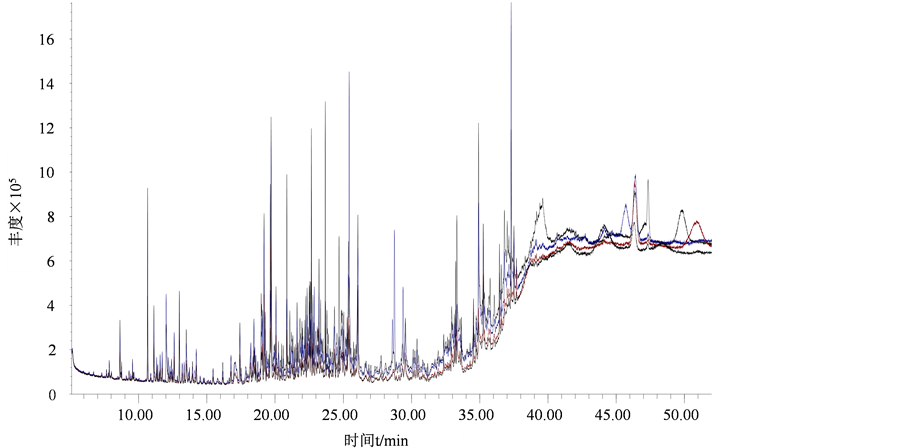摘要:
采用水蒸气蒸馏法,从四川省沐川慈竹叶及竹秆中提取挥发油,通过气相色谱–质谱联机分析法对沐川慈竹叶及竹秆挥发性成分进行分析, 采用面积归一化法测定了挥发油中各组分的相对质量分数。实验利用Nist数据库鉴定了慈竹叶中挥发性组分34种,主要为酮(39.59%)类10种、醛(23.69%)类7种、脂(14.16%)类6种、烷烃(12.41%)类2种、醇(4.22%)类4种、萘(4.65%)类5种等,含量较高的有法尼基丙酮(11.74%)、菲(10.60%)、U-紫罗兰酮(7.23%);竹秆中挥发性组分31种,主要为脂(48.92%)类16种、酮(19.53%)类5种、酚(17.00%)类2种、醇(8.50%)类4种、烷烃(3.29%)类1种、酸(1.45%)类1种、醛(1.27%)类2种等,含量较高的有2,6-二叔丁基对甲基苯酚(16.48%)、十四酸甲酯(9.34%)、抗坏血酸二棕榈酸酯(8.62%)。该实验结果为了解四川省沐川慈竹叶和竹秆中挥发性成分及进一步开发应用提供了依据。
Abstract: The constituents of volatile oils extracted with steam distillation from leaves and culm of Neosi-nocalamus affinis in Muchuan of Sichuan Province were analyzed by GC-MS and their relative con-centrations were acquired with the method of area normalization. The data obtained by the anna-lysis of volatile compounds are identified by Nist Dababase. There are 34 kinds of compositions identified from the leaves, which are mainly 10 ketonecompounds, 7 aldehydecompounds, 6 ester compounds, 2 alkane compounds, 4 alcohol compounds and 5 naphthalene compounds. They make up 39.59% and 23.69%, 14.16%, 12.41%, 4.22% and 4.65% of the identified compositions respectively. The main components from the leaves were Farnesylacetone (11.74%), Phenanthrene (10.60%), Beta-Ionone (7.23%). There are 31 kinds of compositions identified from the culm, which are mainly 16 ester compounds, 5 ketonecompounds, 2 phenolcompounds, 4 alcohol compounds, 1 alkane compound, 1 acid compound and 2 aldehyde compounds. They make up 48.92%, 19.53%, 17.01%, 8.50%, 3.29%, 1.45% and 1.27% of the identified compositions respectively. The main components from the culm were 2-(tert-Butyl)-4,6-dimethyl-phenol (16.48%), Methyl te-tracosanoate (9.34%), L-Ascorbic acid 6-palmitate (8.62%). This study was to provide the experi-mental foundation for knowing more about volatile compounds and reasonable utilization of Neo-sinocalamus affinis in Muchuan of Sichuan Province.
1. 引言
慈竹(Neosinocalamus affinis)为禾本科(Poaceae)箣竹属(Bambusa),特产于我国的四川、云南、贵州、湖南西部、湖北西部、陕西南部和甘肃南部,其中四川省沐川县是全国慈竹主要产区之一,全县竹林面积达5.33万平方公顷,其中,慈竹面积4.0万平方公顷,占全县竹林面积的75% [1] 。慈竹用途极为广泛,其内丰富的竹纤维作为一种天然绿色可再生、可降解的植物纤维,是继棉、麻、毛、丝之后人类应用的又一新型纺织纤维。随着竹材加工利用技术不断创新,新产品层出不穷,它还可作为建筑、家具、农具和工艺品的原料等,并广泛应用于建筑、装饰、家具、包装、运输等多个领域,具有重要的开发价值和市场前景[2] 。
近年来,慈竹中挥发性成分作为竹类提取物中重要的一类次生物质,其香气具有典型的绿叶特征,接近瓜、果、茶的香型,并且具有很高的药用价值,在香料、医药、食品等方面有较大用途。本实验主要是利用水蒸汽蒸馏法,采用气相色谱–质谱(GC-MS)联用技术对四川省沐川慈竹叶和竹秆中挥发性成分进行分析。通过标准谱库检索确定,采用峰面积归一化法确定慈竹叶与竹秆中挥发性成分的百分含量,为了解四川省沐川慈竹中挥发性成分及进一步开发应用提供了依据。
2. 材料与方法
2.1. 材料
慈竹叶与竹秆样品于今年9月上旬采自于四川省乐山市沐川县。将采集的竹叶与竹秆擦去表面浮尘,自然条件下于通风处室内阴干。将各竹秆切成约3 cm × 2 cm长小块,分别与竹叶用电动粉碎机加工成粉末,经过60目筛处理后,于−20℃冰柜中保存备用。
2.2. 方法
2.2.1. 水蒸气蒸馏法提取慈竹挥发性成分
分别称取慈竹叶与竹秆粉末样品20 g,放入1 L的圆底烧瓶中,加入10倍体积蒸馏水,微沸提取6 h,结束蒸馏。收集馏出液500 mL。用氯化钠饱和后,用正己烷萃取。萃取液用无水硫酸钠干燥后过滤,用旋转蒸发器回收正己烷,得到淡黄色的挥发性液体1 mL。密封保存,供分析用,以上试剂均为分析纯。
2.2.2. GC-MS测定慈竹叶与竹秆中挥发性成分
慈竹挥发性成分的测定采用气相色谱–质谱法测定,使用美国安捷伦(GC-MSD 6890N-5973Agilent) [3] 。气相色谱-质谱条件如下,色谱柱:HP-5MS (30 m × 0.25 mm,0.25 µm);程序升温:初始温度60℃,保持5 min,然后以10℃/min的速度升至120℃,保持5 min,再次以10℃/min的速度升至200℃,保持5 min,最后以10℃/min的速度升至280℃,保持15 min;载气为高纯He;载气(He)流速1 mL∙min−1;进样口温度280℃;进样量2 µL;分流进样比为2:1。质谱条件如下,电子轰击(EI)离子源:电子能量70 eV;离子源温度:230℃;传输线温度280℃;四级杆温度150℃;质量扫描范围m/z:15~500 amu [4] 。
质谱图谱分析:利用计算机标准质谱图库(NIST2002)进行检索,参考检索数据符合度(匹配度大于80%),同时结合相关文献进行人工谱图解析,鉴定其化学成分。运用气相色谱面积归一化法确定各个成分的相对百分含量[5] 。
2.3. 数据处理
2.3.1. 定性分析
本文使用Agilent MSD ChemStation软件和Nist数据库分别对沐川慈竹竹叶和竹秆中挥发性组分进行定性分析。Nist数据库(http://www.nist.gov/srd/)检索步骤主要如下:
1) 启动NIST检索
在程序栏NIST Mass Spectral Database的MS Search v2.0进入Nist Search,在安捷伦的工作站的DATA ANALYSIS的Spectrum菜单的Nist Search进入,从Amdis导入谱图。
2) NIST谱库检索
未知物通过NIST谱库与化学工作站链接进行检索,在NIST检索的结果里有Match (检索匹配度),我们对匹配度超过85%的数据进行保留。保留的一种或几种高匹配度的化合物的名称、CAS号、分子式、分子量、离子峰等信息与谱图解析进行对比分析。
2.3.2. 定量分析
本文使用面积归一化法分别对沐川慈竹竹叶和竹秆中挥发性组分进行定量分析,并使用EXCEL等软件进行作图。
3. 结果与讨论
3.1. 慈竹竹叶中挥发性成分分析
慈竹竹叶中水提取物经气相色谱–质谱(GC-MS)联用技术分离分析的总离子流图见图1。

Figure 1. Analysis of volatile compounds from the leaves of Neosinocalamus affinis by GC-MS
图1. 慈竹叶中挥发性物质成分的GC-MS分析谱图
由表1可看出,利用Nist数据库鉴定了慈竹叶中挥发性组分34种,主要为酮(39.59%)类10种、醛(23.69%)类7种、脂(14.16%)类6种、酚(10.60%)类1种、醇(4.22%)类4种、烷烃(1.81%)类1种、萘(4.65%)类5种等。其中慈竹叶中主要挥发性成分为法尼基丙酮(11.74%)、菲(10.60%)、U-紫罗兰酮(7.23%)。法尼基丙酮是一种重要医药中间体;菲常被用于染料和药物中;菲用于制菲醌、合成树脂、农药、防腐剂等;高组分的U-紫罗兰酮具有紫罗兰香气,是合成维生素E和维生素A的重要中间体,也广泛应用在日化香精和烟用香精行业中[6] 。
3.2. 慈竹竹秆中挥发性成分分析
慈竹竹秆水提取物经气相色谱–质谱(GC-MS)联用技术分离分析的总离子流图见图2。利用Nist数据库鉴定了慈竹叶中挥发性组分31种。
由表2可看出,竹秆中挥发性组分31种,主要为脂(48.92%)类16种、酮(19.53%)类5种、酚(17.01%)类2种、醇(8.50%)类4种、烷烃(3.29%)类1种、酸(1.45%)类1种、醛(1.27%)类2种等,含量较高的有2,6-二叔丁基对甲基苯酚(16.48%)、十四酸甲酯(9.34%)、抗坏血酸二棕榈酸酯(8.62%)。2,6-二叔丁基对甲基苯酚在石油工业中是各种润滑油,二次加工汽油、石蜡和其他一些矿物油的优良抗氧剂[7] ;十四酸甲酯又称肉豆蔻酸甲酯是常用于蜂蜜、椰子等食用香精,亦是日用香精和化妆品中的重要成分;[8] 抗坏血酸二棕榈酸酯又称为维生素C棕榈酸酯,可作抗氧化剂,可用于含油脂食品、方便面、食用油脂和氢化植物油[9] 。
3.3. 慈竹叶与竹秆中共有成分分析
慈竹叶与竹秆水提取物经气相色谱-质谱(GC-MS)联用技术分离分析的总离子流图叠加分析见图3。
由上述GC-MS分析结果可知,慈竹竹叶与竹秆中水提取液中共同检出挥发性成分7种,分别为:苯

Table 1. Analysis of volatile compounds from the leaves of Neosinocalamus affinis by GC-MS
表1. 慈竹叶水提取液中挥发性物质成分的GC-MS分析结果

Table 2. Analysis of volatile compounds from the culm of Neosinocalamus affinis by GC-MS
表2. 慈竹秆水提取液中挥发性物质成分的GC-MS分析结果

Figure 2. Analysis of volatile compounds from the culm of Neosinocalamus affinis by GC-MS
图2. 慈竹秆水提取液中挥发性物质成分的GC-MS分析谱图

Figure 3. Analysis of volatile compounds from the leaves and culm of Neosinocalamus affinis by GC-MS
图3. 慈竹叶与竹杆水提取液中挥发性物质成分的GC-MS分析谱图
乙醛、2,6-二甲基环己醇、大马士酮、月桂酸乙酯、法尼基丙酮、棕榈酸乙酯、叶绿醇。在慈竹竹叶与竹秆共有挥发性组分中,苯乙醛是一种香料,具有洋水仙的幽雅香气,在香料、化妆品工业中有重要用途,同时也是合成药物、食品添加剂和农业化学品等精细化学品的重要原料[10] ;大马士酮是玫瑰油重要的香成分之一,用于高级玫瑰系列化妆品香精中,该品是近年发现的化合物[11] ;月桂酸乙酯主要用于配制干酪、椰子、科涅克白兰地和坚果等型香精、香料,亦为良好定香剂;法尼基丙酮是一种重要医药中间体[12] ;棕榈酸乙酯用于配制奶油、牛脂、牛奶、猪肉及鱼类、香辛料用香精,也可用于配制朗姆酒香精[13] ;叶绿醇是合成维生素K及维生素E的原料[14] 。具体含量分析如表3。

Table 3. Analysis of volatile compounds from the leaves and culm of Neosinocalamus affinis by GC-MS
表3. 慈竹叶与竹秆水提取液中挥发性物质成分的GC-MS分析结果
4. 结论
本文通过对四川省沐川慈竹叶与竹秆中挥发性组分的分析,发现慈竹叶中所含苯乙醛(0.58%)、大马士酮(1.71%)、T-紫罗兰酮(1.28%)、U-紫罗兰酮(7.23%)、六氢假紫罗酮(2.77%),这5种化合物的相对含量占总挥发性成分的13.57%;慈竹秆中所含苯乙醛(0.67%)、大马士酮(1.63%)、香叶基丙酮(6.16%)、β-紫罗兰酮(7.96%)、长叶烯(3.29%)、红没药醇(2.05%)、法尼基丙酮(3.02%),这7种化合物的相对含量占总挥发性成分的23.89%。它们都是慈竹中重要的香气成分之一,主要用于化妆品香精中,如苯乙醛是一种香料,具有洋水仙的幽雅香气,在香料、化妆品工业中是重要的原料;高组分的U-紫罗兰酮具有紫罗兰香气,被广泛应用在日化香精和烟用香精行业中。随着人们对慈竹的深入研究,以及提取工艺的不断完善,慈竹将在化妆品、香料、天然抗氧化剂等其它行业得到越来越广泛的应用。该实验结果为了解四川省沐川慈竹叶和竹秆中挥发性成分及进一步开发应用提供了依据。

NOTES
*通讯作者。